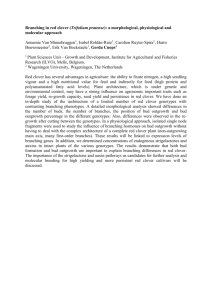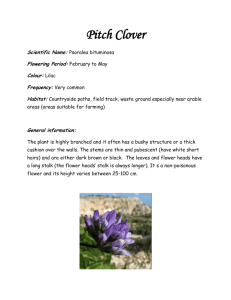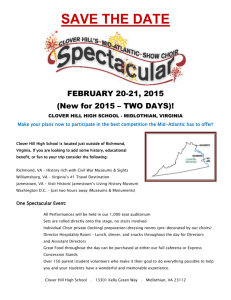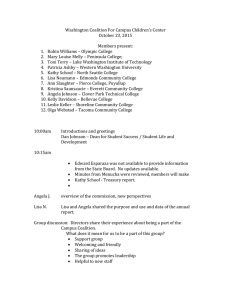Comparison of drought resistance in strawberry clover and white clover Abstract
advertisement
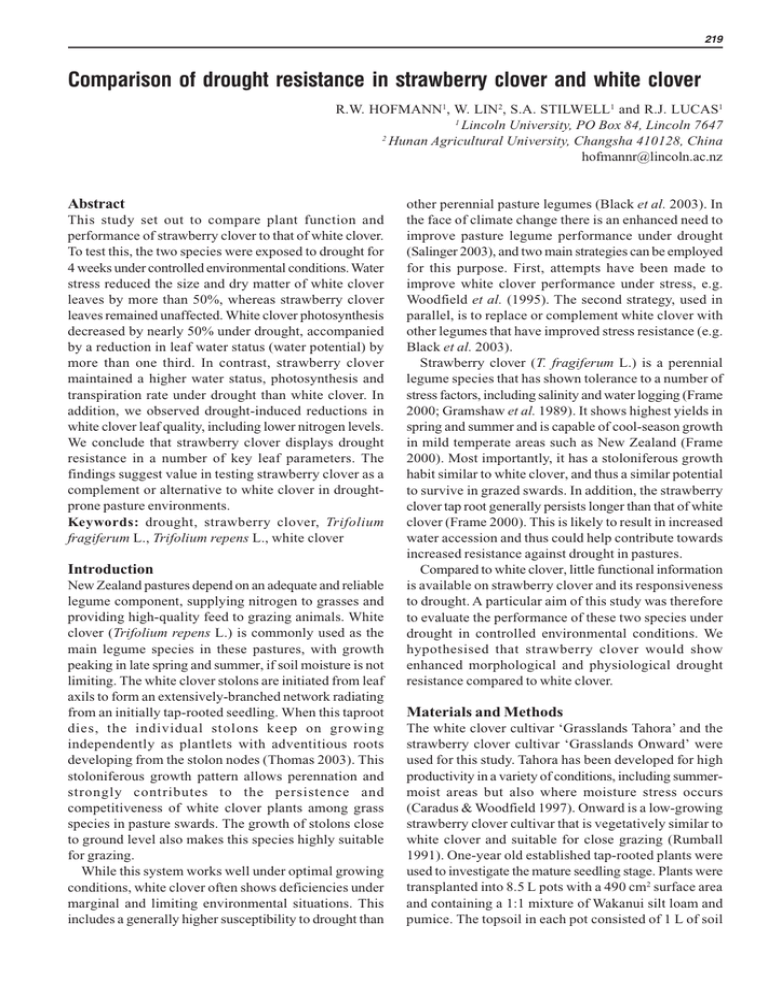
219 Comparison of drought resistance in strawberry clover and white clover R.W. HOFMANN1, W. LIN2, S.A. STILWELL1 and R.J. LUCAS1 1 Lincoln University, PO Box 84, Lincoln 7647 2 Hunan Agricultural University, Changsha 410128, China hofmannr@lincoln.ac.nz Abstract This study set out to compare plant function and performance of strawberry clover to that of white clover. To test this, the two species were exposed to drought for 4 weeks under controlled environmental conditions. Water stress reduced the size and dry matter of white clover leaves by more than 50%, whereas strawberry clover leaves remained unaffected. White clover photosynthesis decreased by nearly 50% under drought, accompanied by a reduction in leaf water status (water potential) by more than one third. In contrast, strawberry clover maintained a higher water status, photosynthesis and transpiration rate under drought than white clover. In addition, we observed drought-induced reductions in white clover leaf quality, including lower nitrogen levels. We conclude that strawberry clover displays drought resistance in a number of key leaf parameters. The findings suggest value in testing strawberry clover as a complement or alternative to white clover in droughtprone pasture environments. Keywords: drought, strawberry clover, Trifolium fragiferum L., Trifolium repens L., white clover Introduction New Zealand pastures depend on an adequate and reliable legume component, supplying nitrogen to grasses and providing high-quality feed to grazing animals. White clover (Trifolium repens L.) is commonly used as the main legume species in these pastures, with growth peaking in late spring and summer, if soil moisture is not limiting. The white clover stolons are initiated from leaf axils to form an extensively-branched network radiating from an initially tap-rooted seedling. When this taproot dies, the individual stolons keep on growing independently as plantlets with adventitious roots developing from the stolon nodes (Thomas 2003). This stoloniferous growth pattern allows perennation and strongly contributes to the persistence and competitiveness of white clover plants among grass species in pasture swards. The growth of stolons close to ground level also makes this species highly suitable for grazing. While this system works well under optimal growing conditions, white clover often shows deficiencies under marginal and limiting environmental situations. This includes a generally higher susceptibility to drought than other perennial pasture legumes (Black et al. 2003). In the face of climate change there is an enhanced need to improve pasture legume performance under drought (Salinger 2003), and two main strategies can be employed for this purpose. First, attempts have been made to improve white clover performance under stress, e.g. Woodfield et al. (1995). The second strategy, used in parallel, is to replace or complement white clover with other legumes that have improved stress resistance (e.g. Black et al. 2003). Strawberry clover (T. fragiferum L.) is a perennial legume species that has shown tolerance to a number of stress factors, including salinity and water logging (Frame 2000; Gramshaw et al. 1989). It shows highest yields in spring and summer and is capable of cool-season growth in mild temperate areas such as New Zealand (Frame 2000). Most importantly, it has a stoloniferous growth habit similar to white clover, and thus a similar potential to survive in grazed swards. In addition, the strawberry clover tap root generally persists longer than that of white clover (Frame 2000). This is likely to result in increased water accession and thus could help contribute towards increased resistance against drought in pastures. Compared to white clover, little functional information is available on strawberry clover and its responsiveness to drought. A particular aim of this study was therefore to evaluate the performance of these two species under drought in controlled environmental conditions. We hypothesised that strawberry clover would show enhanced morphological and physiological drought resistance compared to white clover. Materials and Methods The white clover cultivar ‘Grasslands Tahora’ and the strawberry clover cultivar ‘Grasslands Onward’ were used for this study. Tahora has been developed for high productivity in a variety of conditions, including summermoist areas but also where moisture stress occurs (Caradus & Woodfield 1997). Onward is a low-growing strawberry clover cultivar that is vegetatively similar to white clover and suitable for close grazing (Rumball 1991). One-year old established tap-rooted plants were used to investigate the mature seedling stage. Plants were transplanted into 8.5 L pots with a 490 cm2 surface area and containing a 1:1 mixture of Wakanui silt loam and pumice. The topsoil in each pot consisted of 1 L of soil 220 Proceedings of the New Zealand Grassland Association 69: seedling mix which contained a 4:1 mixture of composted bark:pumice, as well as Hydraflo wetting agent, Osmocote slow-release fertiliser and lime. The pots were arranged in a large walk-in growth chamber in a randomised block design and each treatment was replicated four times. There was a total of 16 pots in the experiment: two clover species × two moisture levels × four replicates. Plants were grown at a day:night cycle of 16h:8h at 20ºC:10ºC. Light levels (photosynthetic photon flux) during daytime were approximately 680 µmol/m2/sec and relative humidity was around 50%. After an acclimation period of 4 weeks in the controlled environment, plants remained either well-watered or were exposed to drought for 4 weeks. The water treatments were monitored gravimetrically every day (Barbour et al. 1995). Well-watered plants were watered to 5% (by weight) below field capacity of the soil, while droughttreated plants were watered to 5% (by weight) above the permanent wilting point. Plant traits were measured at the end of the drought period. Leaf parameters were measured on young, fully open, distal leaves, collected between 10 am-11 am at harvest time. Leaf size was determined with a LI-COR 3100 leaf area meter on four randomly chosen leaves per pot. The same leaves were also used for the determination of petiole length, and for leaf mass parameters to measure relative leaf water content (Belaygue et al. 1996), including lamina fresh and turgid weight, as well as lamina dry weight. The latter, as well as above-ground plant biomass parameters were determined after ovendrying at 80ºC for 48 h. A young, fully unfolded first leaf was labelled in each pot before the onset of the drought treatment to determine leaf appearance rate and stolon elongation rate. Photosynthesis rates, stomatal conductances and transpiration rates of fully unfolded first leaves were determined with the LI-COR 6400 Gas Exchange System (Black et al. 2003). A Minolta Spad 502 Meter was used to estimate the nitrogen levels of these leaves (Kantety et al. 1996). The instrument performs fast and nondestructive measurements of leaf chlorophyll content which can be used to predict crop nitrogen status (Kantety et al. 1996). Results are quoted as arbitrary Spad units to quantify relative differences between treatments within an experiment. Leaf water potential was determined as the petiole xylem pressure potential with a pressure chamber (PMS Instrument Co.) (Hofmann et al. 2003). Leaf samples for proline analysis were frozen in liquid nitrogen immediately at harvest, and subsequently freezedried, ground and analysed using established methods (Hofmann et al. 2003). Statistical analysis was performed with the General Analysis of Variance procedure in GENSTAT (Genstat 1993), using either raw values or values transformed to 219–222 (2007) a logarithmic scale to adjust some of the morphological parameters for homogeneity of variance. In addition, differences between interaction means (drought × species) were analysed using the least significant difference (LSD) values from the ANOVA at P<0.05. Results and Discussion This study provides the first detailed comparison between strawberry clover and white clover across a number of morphological and physiological features, including drought resistance. White clover showed significantly (P<0.01) more pronounced drought responses at the leaf level (Table 1), including marked decreases of more than 50% in individual leaf size and leaf dry weight, as well as larger reductions in petiole length than strawberry clover. Comparable drought effects on white clover leaf morphology have been noted in previous studies (Barbour et al. 1995; Belaygue et al. 1996). These observations were mirrored by effects on key aspects of white clover physiology (Table 2). This included a significant (P<0.05) drought-induced reduction by more than a third of the water status of white clover, measured as leaf water potential. Compared to strawberry clover, the latter response is likely to have resulted in the larger effect of drought (P<0.01) on white clover stomatal conductance to reduce transpiration rates and water loss (Table 2). Similar has been found in other studies of drought responses in white clover (HoghJensen & Schjoerring 1997). The changes in stomatal conductance were accompanied by a significant decrease in photosynthesis rates of nearly 50% in white clover (P<0.05), but not in strawberry clover (Table 2). Furthermore, these drought-induced differences in leaf function between the two species were reflected by differential impacts on leaf quality. Drought-exposed white clover showed a decrease in relative nitrogen levels of 8%, which was significantly different (P<0.05) from the increase observed in strawberry clover (Table 2). The relative nitrogen measurement used here is closely correlated with chlorophyll levels, which have been shown to decrease in white clover under drought (Hofmann et al. 2003). Drought also induced similar reductions in the relative leaf water content in white clover (P<0.05), but not in strawberry clover (Table 2). The lower leaf water status in white clover was accompanied by a highly significant (P<0.001) three-fold increase in the levels of proline (Table 2), an amino acid that can act in its free form as a compatible solute to protect plant cells against osmotic stress resulting from drought (Hofmann et al. 2003). Large increases in such compounds for stress protection can divert resources from metabolic functions that are normally used for growth and thus contribute – together with the observed Comparison of drought resistance in strawberry clover and white clover (R.W. Hofmann, W. Lin, S.A. Stilwell & R.J. Lucas) Table 1 Morphological traits in white clover (WC) and strawberry clover (STC) grown under well-watered (WW) and drought (DR) conditions (average values ± standard errors). Where the difference between WW and DR values was significant for a species (least significant difference in the ANOVA at P<0.05), the corresponding change in DR plants was expressed as a percentage of the WW plants. DM dry matter; ns non-significant. Trait Species 2 Leaf size (cm ) Leaf DM (mg) Petiole length (cm) Aboveground DM (g/plant) Stolon elongation rate (mm/d) Leaf appearance rate (/d) Table 2 221 WC STC WC STC WC STC WC STC WC STC WC STC WW 5.80 4.27 25.0 20.6 16.2 7.39 30.5 30.1 2.80 3.42 0.143 0.114 ± ± ± ± ± ± ± ± ± ± ± ± 0.52 0.28 3.02 1.29 0.38 0.72 2.25 3.97 0.74 0.89 0.029 0.015 DR 2.42 3.90 10.9 19.3 6.69 4.89 11.0 10.2 1.76 1.36 0.109 0.121 ± ± ± ± ± ± ± ± ± ± ± ± 0.21 0.39 0.87 2.19 0.57 0.28 1.07 1.83 0.45 0.53 0.012 0.017 % Change -58 ns -56 ns -59 -34 -64 -66 ns -60 ns ns Physiological traits in white clover (WC) and strawberry clover (STC) grown under well-watered (WW) and drought (DR) conditions (average values ± standard errors). Where the difference between WW and DR values was significant for a species (least significant difference in the ANOVA at P<0.05), the corresponding change in DR plants was expressed as a percentage of the WW plants. DM dry matter; ns non-significant. Trait Leaf water potential (MPa) Relative leaf water content (%) Relative nitrogen levels (Spad units) Proline (mg/g DM) Net photosynthesis A (µmol CO2/m/s) Stomatal conductance g (mol H2O/m/s) Transpiration rate E (mmol H2O/m/s) Species WC STC WC STC WC STC WC STC WC STC WC STC WC STC WW -1.23 -1.25 89.5 92.4 52.7 42.2 0.450 0.316 15.7 15.0 0.271 0.199 3.65 2.75 changes in white clover leaf physiology – to a reduction in plant productivity (Grime & Campbell 1991). Strawberry clover showed a drought-induced decrease in stolon elongation rates (Table 1, P<0.05). Reductions in aboveground biomass production under drought were similar for both species (Table 1, P<0.001). Our data suggest that in white clover this was largely due to drought effects on leaf parameters, while stolon development seemed to be primarily affected in strawberry clover. In this study, strawberry clover nodal root formation was not as pronounced compared to white clover and this could have resulted in a localised reduction of water supply to the stolons under drought. In conclusion, strawberry clover displayed a number of functional and morphological features of drought resistance, including maintenance of leaf size, of leaf quality traits, of leaf water status and of photosynthesis rates. This may contribute to higher-quality leaf dry matter ± ± ± ± ± ± ± ± ± ± ± ± ± ± 0.06 0.12 0.44 2.35 3.68 1.40 0.017 0.043 0.58 1.14 0.017 0.009 0.18 0.12 DR -1.70 -1.49 82.7 89.0 48.7 49.1 1.420 0.406 8.19 12.1 0.068 0.110 1.02 1.65 ± ± ± ± ± ± ± ± ± ± ± ± ± ± 0.10 0.06 1.46 1.18 2.09 0.69 0.129 0.054 1.25 1.55 0.009 0.017 0.12 0.25 % Change -39 ns -8 ns -8 +16 +216 ns -48 ns -75 -44 -72 -40 supply under drought when compared with white clover. The results also point at the potential for plant improvement of strawberry clover, e.g. the development of nodal roots. These findings provide the starting point for future field experimentation under limiting water supply, including investigations of leaf and stolon development, as well as long-term plant performance and survival to test the use of strawberry clover as a complement or alternative to white clover in grazed pastures. REFERENCES Barbour, M.; Caradus, J.R.; Woodfield, D.R.; Silvester, W.B. 1995. Water stress and water use efficiency of ten white clover cultivars. White Clover: New Zealand’s Competitive Edge. Agronomy Society of New Zealand Special Publication 11/Grassland Research and Practice Series 6: 159-162. 222 Proceedings of the New Zealand Grassland Association 69: Belaygue, C.; Wery, J.; Cowan, A.A.; Tardieu, F. 1996. Contribution of leaf expansion, rate of leaf appearance, and stolon branching to growth of plant leaf area under water deficit in white clover. Crop Science 36: 12401246. Black, A.D.; Moot, D.J.; Lucas, R.J. 2003. Seasonal growth and development of Caucasian and white clovers under irrigated and dryland conditions. Legumes for Dryland Pastures. Grassland Research and Practice Series 11: 81-90. Caradus, J.R.; Woodfield, D.R. 1997. World checklist of white clover varieties II. New Zealand Journal of Agricultural Research 40: 115-206. Frame, J. 2000. Grasslands species profiles: Trifolium fragiferum L. – Food and Agriculture Organization of the United Nations, http://www.fao.org/ag/AGP/ AGPC/doc/GBASE/data/Pf000500.htm. Genstat 1993. Genstat 5, Release 3 Reference Manual. Clarendon Press, Oxford. Gramshaw, D.; Read, J.W.; Collins, W.J.; Carter, E.D. 1989. Sown pastures and legume persistence: an Australian overview. pp. 1-21. In: Persistence of forage legumes. Eds. Marten, G.C. et al. American Society of Agronomy, Madison, Wisconsin. Grime, J.P.; Campbell, B.D. 1991. Growth rate, habitat productivity and plant strategy as predictors of stress response. pp. 143-159. In: Response of plants to multiple stresses. Eds. Mooney, H.A.; Winner, W. E.; Pell, E.J. Academic Press, Orlando. 219–222 (2007) Hofmann, R.W.; Campbell, B.D.; Bloor, S.J.; Swinny, E.E.; Markham, K.R.; Ryan, K.G.; Fountain, D.W. 2003. Responses to UV-B radiation in Trifolium repens L. – physiological links to plant productivity and water availability. Plant, Cell and Environment 26: 603-612. HoghJensen, H.; Schjoerring, J.K. 1997. Effects of drought and inorganic N form on nitrogen fixation and carbon isotope discrimination in Trifolium repens. Plant Physiology and Biochemistry 35: 55-62. Kantety, R.V.; vanSanten, E.; Woods, F.M.; Wood, C.W. 1996. Chlorophyll meter predicts nitrogen status of tall fescue. Journal of Plant Nutrition 19: 881-899. Rumball, W. 1991. ‘Grasslands Onward’ strawberry clover (Trifolium fragiferum L.). New Zealand Journal of Agricultural Research 34: 131-133. Salinger, J. 2003. Climate reality – actual and expected. Legumes for Dryland Pastures. Grassland Research and Practice Series 11: 13-18. Thomas, R.G. 2003. Comparative growth forms of dryland forage legumes. Legumes for Dryland Pastures. Grassland Research and Practice Series 11: 19-25. Woodfield, D.R.; Caradus, J.R.; Cousins, G.R.; Dunn, T. 1995. Response to selection for increased taproot diameter. White Clover: New Zealand’s Competitive Edge. Agronomy Society of New Zealand Special Publication 11/Grassland Research and Practice Series 6: 141-143.
